Jiahuan Zhou
Hacking Hallucinations of MLLMs with Causal Sufficiency and Necessity
Aug 06, 2025



Abstract:Multimodal Large Language Models (MLLMs) have demonstrated impressive capabilities across vision-language tasks. However, they may suffer from hallucinations--generating outputs that are semantically inconsistent with the input image or text. Through causal analyses, we find that: (i) hallucinations with omission may arise from the failure to adequately capture essential causal factors, and (ii) hallucinations with fabrication are likely caused by the model being misled by non-causal cues. To address these challenges, we propose a novel reinforcement learning framework guided by causal completeness, which jointly considers both causal sufficiency and causal necessity of tokens. Specifically, we evaluate each token's standalone contribution and counterfactual indispensability to define a token-level causal completeness reward. This reward is used to construct a causally informed advantage function within the GRPO optimization framework, encouraging the model to focus on tokens that are both causally sufficient and necessary for accurate generation. Experimental results across various benchmark datasets and tasks demonstrate the effectiveness of our approach, which effectively mitigates hallucinations in MLLMs.
Self-Reinforcing Prototype Evolution with Dual-Knowledge Cooperation for Semi-Supervised Lifelong Person Re-Identification
Jul 02, 2025Abstract:Current lifelong person re-identification (LReID) methods predominantly rely on fully labeled data streams. However, in real-world scenarios where annotation resources are limited, a vast amount of unlabeled data coexists with scarce labeled samples, leading to the Semi-Supervised LReID (Semi-LReID) problem where LReID methods suffer severe performance degradation. Existing LReID methods, even when combined with semi-supervised strategies, suffer from limited long-term adaptation performance due to struggling with the noisy knowledge occurring during unlabeled data utilization. In this paper, we pioneer the investigation of Semi-LReID, introducing a novel Self-Reinforcing Prototype Evolution with Dual-Knowledge Cooperation framework (SPRED). Our key innovation lies in establishing a self-reinforcing cycle between dynamic prototype-guided pseudo-label generation and new-old knowledge collaborative purification to enhance the utilization of unlabeled data. Specifically, learnable identity prototypes are introduced to dynamically capture the identity distributions and generate high-quality pseudo-labels. Then, the dual-knowledge cooperation scheme integrates current model specialization and historical model generalization, refining noisy pseudo-labels. Through this cyclic design, reliable pseudo-labels are progressively mined to improve current-stage learning and ensure positive knowledge propagation over long-term learning. Experiments on the established Semi-LReID benchmarks show that our SPRED achieves state-of-the-art performance. Our source code is available at https://github.com/zhoujiahuan1991/ICCV2025-SPRED
Vision Graph Prompting via Semantic Low-Rank Decomposition
May 07, 2025Abstract:Vision GNN (ViG) demonstrates superior performance by representing images as graph structures, providing a more natural way to capture irregular semantic patterns beyond traditional grid or sequence-based representations. To efficiently adapt ViG to downstream tasks, parameter-efficient fine-tuning techniques like visual prompting become increasingly essential. However, existing prompting methods are primarily designed for Transformer-based models, neglecting the rich topological relationships among nodes and edges in graph-based representations, limiting their capacity to model complex semantics. In this paper, we propose Vision Graph Prompting (VGP), a novel framework tailored for vision graph structures. Our core insight reveals that semantically connected components in the graph exhibit low-rank properties. Building on this observation, we introduce a semantic low-rank prompting method that decomposes low-rank semantic features and integrates them with prompts on vision graph topologies, capturing both global structural patterns and fine-grained semantic dependencies. Extensive experiments demonstrate our method significantly improves ViG's transfer performance on diverse downstream tasks, achieving results comparable to full fine-tuning while maintaining parameter efficiency. Our code is available at https://github.com/zhoujiahuan1991/ICML2025-VGP.
GAPrompt: Geometry-Aware Point Cloud Prompt for 3D Vision Model
May 07, 2025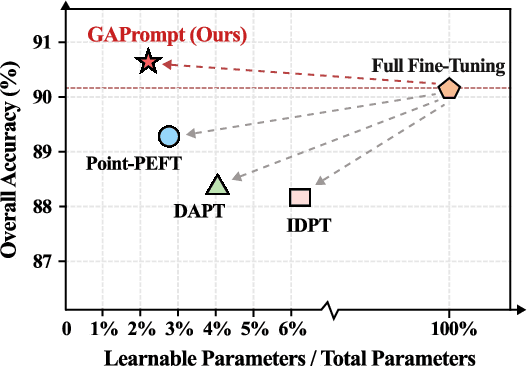
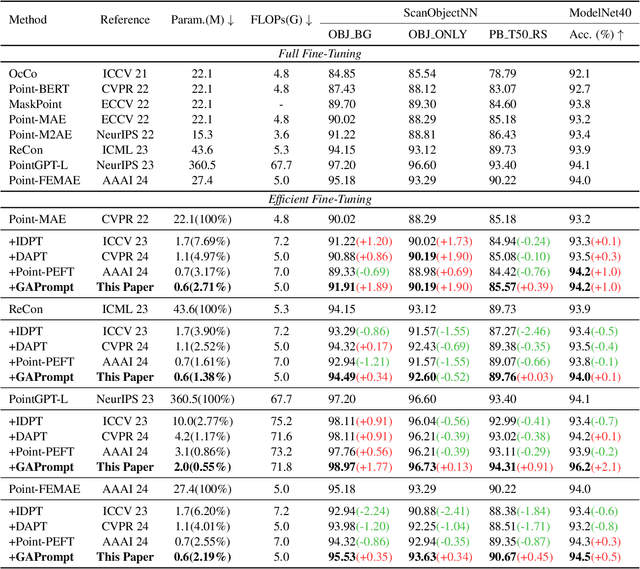
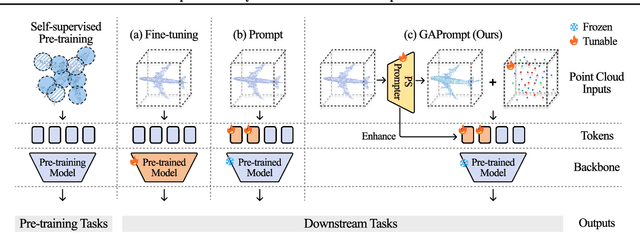
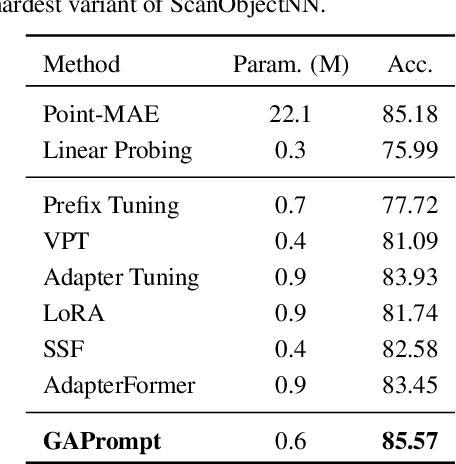
Abstract:Pre-trained 3D vision models have gained significant attention for their promising performance on point cloud data. However, fully fine-tuning these models for downstream tasks is computationally expensive and storage-intensive. Existing parameter-efficient fine-tuning (PEFT) approaches, which focus primarily on input token prompting, struggle to achieve competitive performance due to their limited ability to capture the geometric information inherent in point clouds. To address this challenge, we propose a novel Geometry-Aware Point Cloud Prompt (GAPrompt) that leverages geometric cues to enhance the adaptability of 3D vision models. First, we introduce a Point Prompt that serves as an auxiliary input alongside the original point cloud, explicitly guiding the model to capture fine-grained geometric details. Additionally, we present a Point Shift Prompter designed to extract global shape information from the point cloud, enabling instance-specific geometric adjustments at the input level. Moreover, our proposed Prompt Propagation mechanism incorporates the shape information into the model's feature extraction process, further strengthening its ability to capture essential geometric characteristics. Extensive experiments demonstrate that GAPrompt significantly outperforms state-of-the-art PEFT methods and achieves competitive results compared to full fine-tuning on various benchmarks, while utilizing only 2.19% of trainable parameters. Our code is available at https://github.com/zhoujiahuan1991/ICML2025-VGP.
Componential Prompt-Knowledge Alignment for Domain Incremental Learning
May 07, 2025Abstract:Domain Incremental Learning (DIL) aims to learn from non-stationary data streams across domains while retaining and utilizing past knowledge. Although prompt-based methods effectively store multi-domain knowledge in prompt parameters and obtain advanced performance through cross-domain prompt fusion, we reveal an intrinsic limitation: component-wise misalignment between domain-specific prompts leads to conflicting knowledge integration and degraded predictions. This arises from the random positioning of knowledge components within prompts, where irrelevant component fusion introduces interference.To address this, we propose Componential Prompt-Knowledge Alignment (KA-Prompt), a novel prompt-based DIL method that introduces component-aware prompt-knowledge alignment during training, significantly improving both the learning and inference capacity of the model. KA-Prompt operates in two phases: (1) Initial Componential Structure Configuring, where a set of old prompts containing knowledge relevant to the new domain are mined via greedy search, which is then exploited to initialize new prompts to achieve reusable knowledge transfer and establish intrinsic alignment between new and old prompts. (2) Online Alignment Preservation, which dynamically identifies the target old prompts and applies adaptive componential consistency constraints as new prompts evolve. Extensive experiments on DIL benchmarks demonstrate the effectiveness of our KA-Prompt. Our source code is available at https://github.com/zhoujiahuan1991/ICML2025-KA-Prompt
Token Coordinated Prompt Attention is Needed for Visual Prompting
May 05, 2025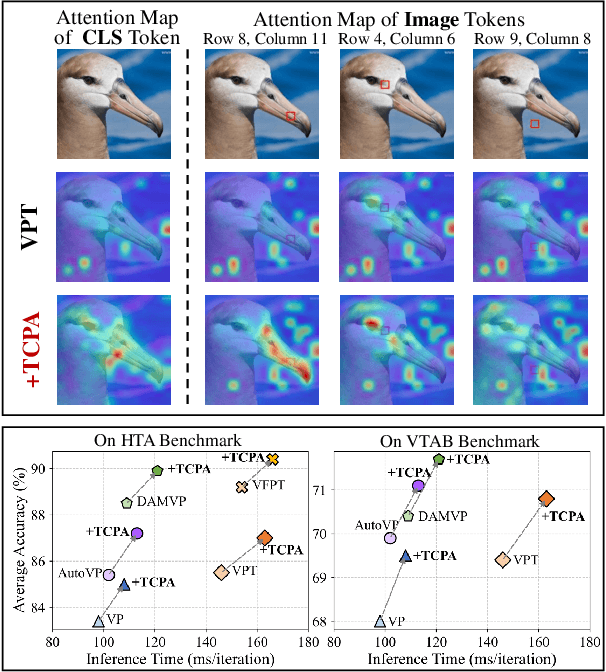
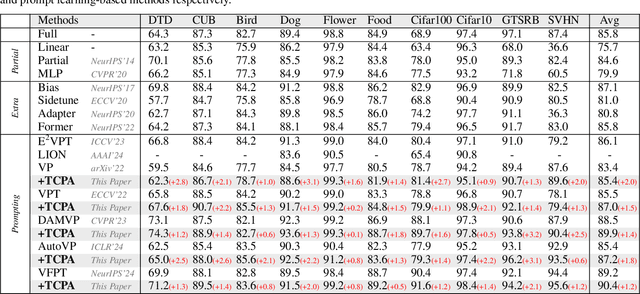
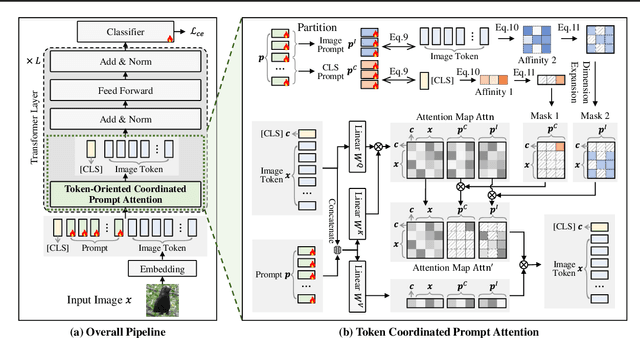
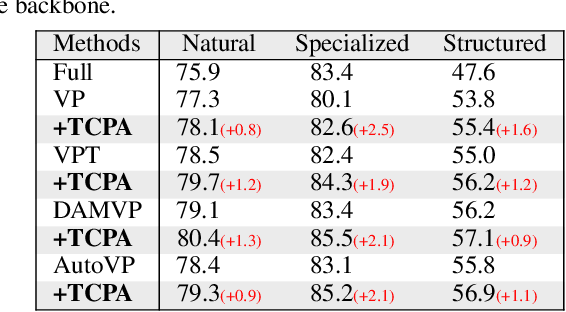
Abstract:Visual prompting techniques are widely used to efficiently fine-tune pretrained Vision Transformers (ViT) by learning a small set of shared prompts for all tokens. However, existing methods overlook the unique roles of different tokens in conveying discriminative information and interact with all tokens using the same prompts, thereby limiting the representational capacity of ViT. This often leads to indistinguishable and biased prompt-extracted features, hindering performance. To address this issue, we propose a plug-and-play Token Coordinated Prompt Attention (TCPA) module, which assigns specific coordinated prompts to different tokens for attention-based interactions. Firstly, recognizing the distinct functions of CLS and image tokens-global information aggregation and local feature extraction, we disentangle the prompts into CLS Prompts and Image Prompts, which interact exclusively with CLS tokens and image tokens through attention mechanisms. This enhances their respective discriminative abilities. Furthermore, as different image tokens correspond to distinct image patches and contain diverse information, we employ a matching function to automatically assign coordinated prompts to individual tokens. This enables more precise attention interactions, improving the diversity and representational capacity of the extracted features. Extensive experiments across various benchmarks demonstrate that TCPA significantly enhances the diversity and discriminative power of the extracted features. The code is available at https://github.com/zhoujiahuan1991/ICML2025-TCPA.
Incremental Object Keypoint Learning
Mar 26, 2025Abstract:Existing progress in object keypoint estimation primarily benefits from the conventional supervised learning paradigm based on numerous data labeled with pre-defined keypoints. However, these well-trained models can hardly detect the undefined new keypoints in test time, which largely hinders their feasibility for diverse downstream tasks. To handle this, various solutions are explored but still suffer from either limited generalizability or transferability. Therefore, in this paper, we explore a novel keypoint learning paradigm in that we only annotate new keypoints in the new data and incrementally train the model, without retaining any old data, called Incremental object Keypoint Learning (IKL). A two-stage learning scheme as a novel baseline tailored to IKL is developed. In the first Knowledge Association stage, given the data labeled with only new keypoints, an auxiliary KA-Net is trained to automatically associate the old keypoints to these new ones based on their spatial and intrinsic anatomical relations. In the second Mutual Promotion stage, based on a keypoint-oriented spatial distillation loss, we jointly leverage the auxiliary KA-Net and the old model for knowledge consolidation to mutually promote the estimation of all old and new keypoints. Owing to the investigation of the correlations between new and old keypoints, our proposed method can not just effectively mitigate the catastrophic forgetting of old keypoints, but may even further improve the estimation of the old ones and achieve a positive transfer beyond anti-forgetting. Such an observation has been solidly verified by extensive experiments on different keypoint datasets, where our method exhibits superiority in alleviating the forgetting issue and boosting performance while enjoying labeling efficiency even under the low-shot data regime.
STOP: Integrated Spatial-Temporal Dynamic Prompting for Video Understanding
Mar 20, 2025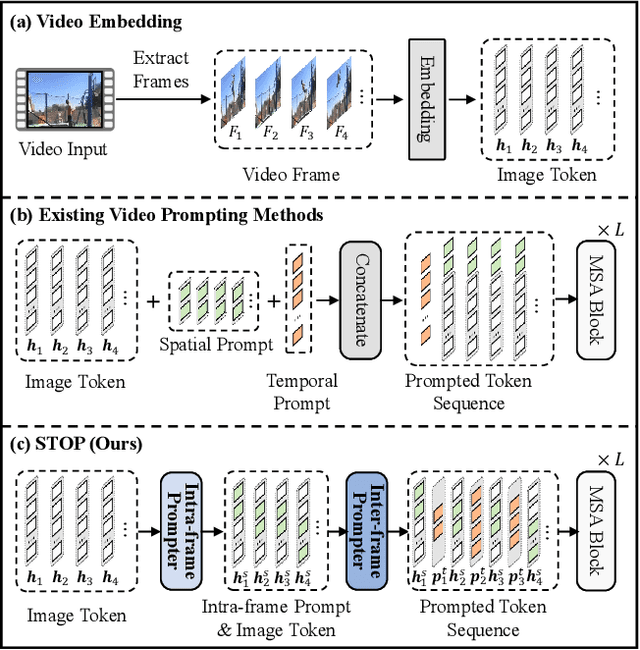
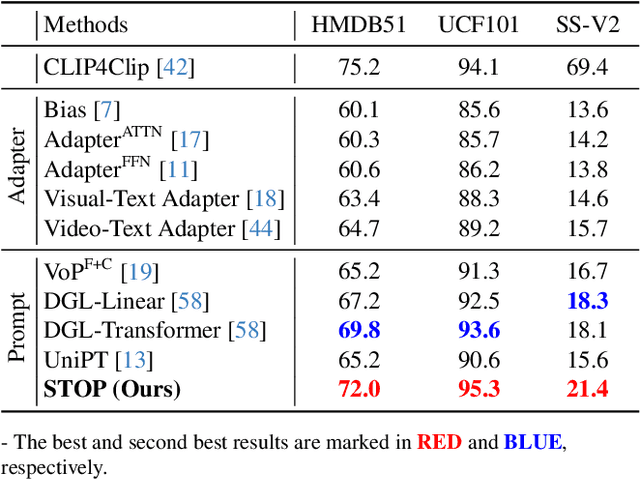
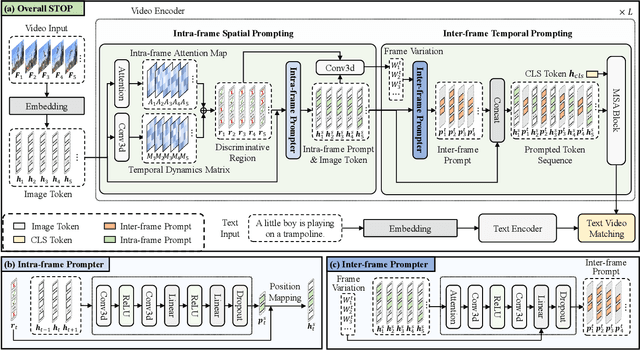
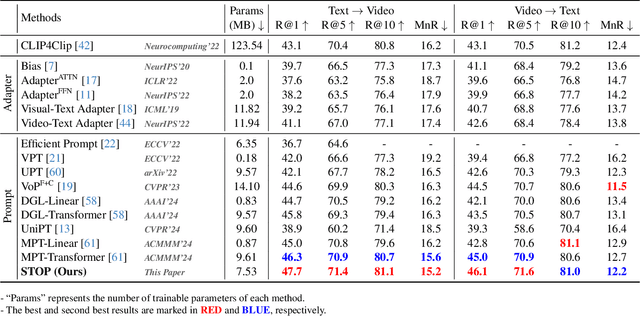
Abstract:Pre-trained on tremendous image-text pairs, vision-language models like CLIP have demonstrated promising zero-shot generalization across numerous image-based tasks. However, extending these capabilities to video tasks remains challenging due to limited labeled video data and high training costs. Recent video prompting methods attempt to adapt CLIP for video tasks by introducing learnable prompts, but they typically rely on a single static prompt for all video sequences, overlooking the diverse temporal dynamics and spatial variations that exist across frames. This limitation significantly hinders the model's ability to capture essential temporal information for effective video understanding. To address this, we propose an integrated Spatial-TempOral dynamic Prompting (STOP) model which consists of two complementary modules, the intra-frame spatial prompting and inter-frame temporal prompting. Our intra-frame spatial prompts are designed to adaptively highlight discriminative regions within each frame by leveraging intra-frame attention and temporal variation, allowing the model to focus on areas with substantial temporal dynamics and capture fine-grained spatial details. Additionally, to highlight the varying importance of frames for video understanding, we further introduce inter-frame temporal prompts, dynamically inserting prompts between frames with high temporal variance as measured by frame similarity. This enables the model to prioritize key frames and enhances its capacity to understand temporal dependencies across sequences. Extensive experiments on various video benchmarks demonstrate that STOP consistently achieves superior performance against state-of-the-art methods. The code is available at https://github.com/zhoujiahuan1991/CVPR2025-STOP.
SCAP: Transductive Test-Time Adaptation via Supportive Clique-based Attribute Prompting
Mar 17, 2025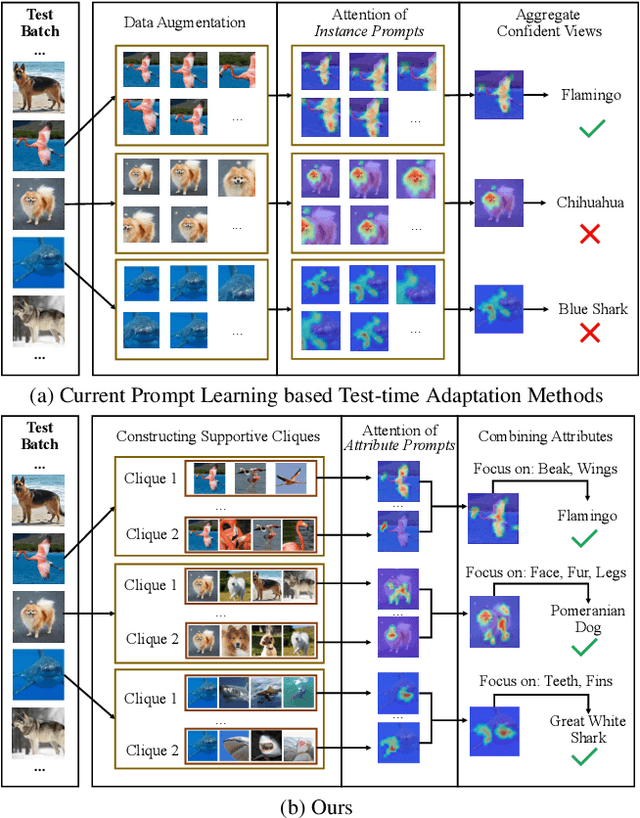
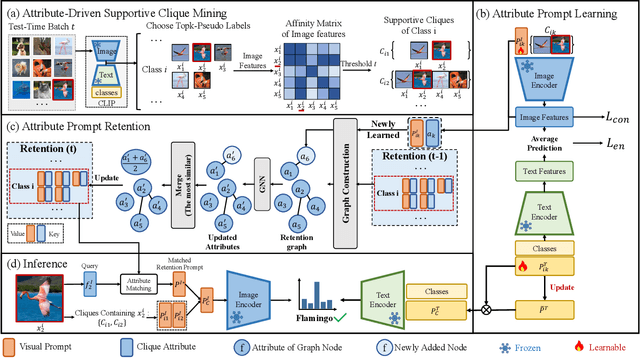
Abstract:Vision-language models (VLMs) encounter considerable challenges when adapting to domain shifts stemming from changes in data distribution. Test-time adaptation (TTA) has emerged as a promising approach to enhance VLM performance under such conditions. In practice, test data often arrives in batches, leading to increasing interest in the transductive TTA setting. However, existing TTA methods primarily focus on individual test samples, overlooking crucial cross-sample correlations within a batch. While recent ViT-based TTA methods have introduced batch-level adaptation, they remain suboptimal for VLMs due to inadequate integration of the text modality. To address these limitations, we propose a novel transductive TTA framework, Supportive Clique-based Attribute Prompting (SCAP), which effectively combines visual and textual information to enhance adaptation by generating fine-grained attribute prompts across test batches. SCAP first forms supportive cliques of test samples in an unsupervised manner based on visual similarity and learns an attribute prompt for each clique, capturing shared attributes critical for adaptation. For each test sample, SCAP aggregates attribute prompts from its associated cliques, providing enriched contextual information. To ensure adaptability over time, we incorporate a retention module that dynamically updates attribute prompts and their associated attributes as new data arrives. Comprehensive experiments across multiple benchmarks demonstrate that SCAP outperforms existing state-of-the-art methods, significantly advancing VLM generalization under domain shifts. Our code is available at https://github.com/zhoujiahuan1991/CVPR2025-SCAP.
DriveEditor: A Unified 3D Information-Guided Framework for Controllable Object Editing in Driving Scenes
Dec 27, 2024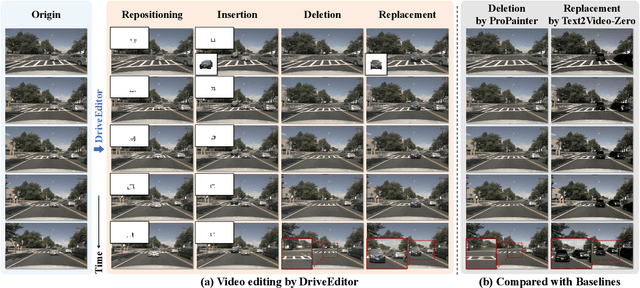
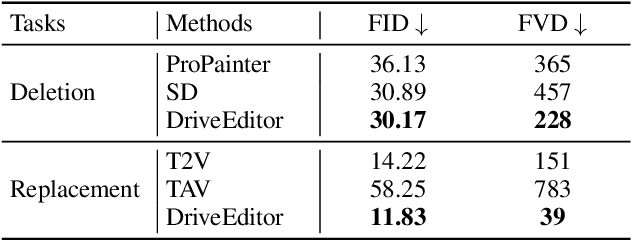
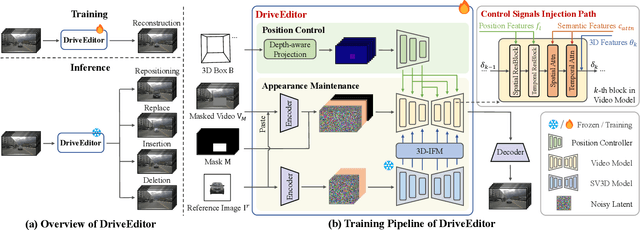
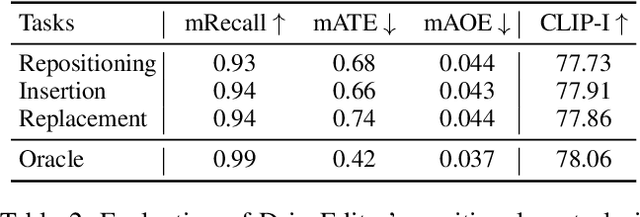
Abstract:Vision-centric autonomous driving systems require diverse data for robust training and evaluation, which can be augmented by manipulating object positions and appearances within existing scene captures. While recent advancements in diffusion models have shown promise in video editing, their application to object manipulation in driving scenarios remains challenging due to imprecise positional control and difficulties in preserving high-fidelity object appearances. To address these challenges in position and appearance control, we introduce DriveEditor, a diffusion-based framework for object editing in driving videos. DriveEditor offers a unified framework for comprehensive object editing operations, including repositioning, replacement, deletion, and insertion. These diverse manipulations are all achieved through a shared set of varying inputs, processed by identical position control and appearance maintenance modules. The position control module projects the given 3D bounding box while preserving depth information and hierarchically injects it into the diffusion process, enabling precise control over object position and orientation. The appearance maintenance module preserves consistent attributes with a single reference image by employing a three-tiered approach: low-level detail preservation, high-level semantic maintenance, and the integration of 3D priors from a novel view synthesis model. Extensive qualitative and quantitative evaluations on the nuScenes dataset demonstrate DriveEditor's exceptional fidelity and controllability in generating diverse driving scene edits, as well as its remarkable ability to facilitate downstream tasks.
 Add to Chrome
Add to Chrome Add to Firefox
Add to Firefox Add to Edge
Add to Edge